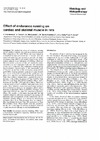Please use this identifier to cite or link to this item:
https://accedacris.ulpgc.es/jspui/handle/10553/50986
| Title: | Effect of endurance running on cardiac and skeletal muscle in rats | Authors: | Díaz-Herrera, P. Torres, A. Morcuende, J. A. García-Castellano, J. M. Calbet, J. A.L. Sarrat, R. |
UNESCO Clasification: | 241106 Fisiología del ejercicio | Keywords: | Endurance exercise training Fiber type composition Oxidative capacity Skeletal muscle Cardiac hypertrophy |
Issue Date: | 2001 | Publisher: | 0213-3911 | Journal: | Histology and Histopathology | Abstract: | We studied the effect of resistance running on left cardiac ventricle size and rectus femoris muscle fiber composition. Ten male Wistar rats were trained on a treadmill 6 days per week for 12 weeks. Ten rats remained sedentary and served as controls. A higher endurance time (40%) and cardiac hypertrophy in the trained animals were indicators of training efficiency. Morphometric analysis of the left ventricle cross-sectional area, left ventricular wall, and left ventricular cavity were evaluated. The endurance-running group demonstrated a hypertrophy of the ventricular wall (22%) and an increase in the ventricular cavity (25%); (p<0.0001). Semi-quantitative analysis of rectus femoris fiber-type composition and of the oxidative and glycolytic capacity was histochemically performed. Endurance running demonstrated a significant (p<0.01) increase in the relative frequency of Type I (24%), Type IIA (8%) and Type IIX (16%) oxidative fibers, and a decrease in Type IIB (20%) glycolytic fibers. There was a hypertrophy of both oxidative and glycolytic fiber types. The relative cross-sectional area analysis demonstrated an increase in oxidative fibers and a decrease in glycolytic fibers (p<0.0001). Changes were especially evident for Type IIX oxidative-glycolytic fibers. The results of this study indicate that the left ventricle adapts to endurance running by increasing wall thickness and enlargement of the ventricular cavity. Skeletal muscle adapts to training by increasing oxidative fiber Type. This increase may be related to fiber transformation from Type IIB glycolytic to Type IIX oxidative fibers. These results open the possibility for the use of this type of exercise to prevent muscular atrophy associated with age or post-immobilization. | URI: | https://accedacris.ulpgc.es/handle/10553/50986 | ISSN: | 0213-3911 | DOI: | 10.14670/HH-16.29 | Source: | Histology and Histopathology[ISSN 0213-3911],v. 16, p. 29-35 |
| Appears in Collections: | Artículos |
Items in accedaCRIS are protected by copyright, with all rights reserved, unless otherwise indicated.
